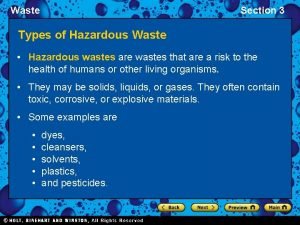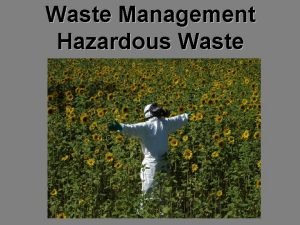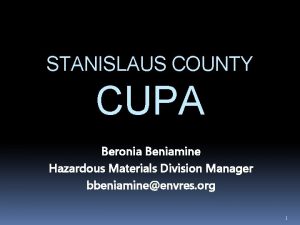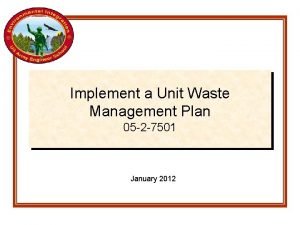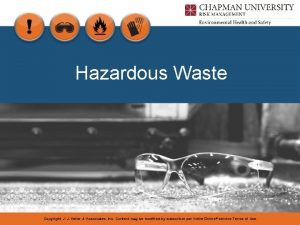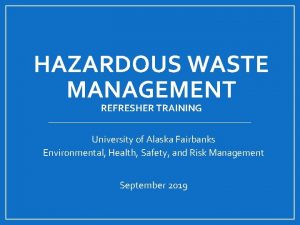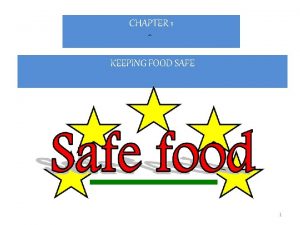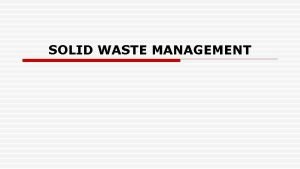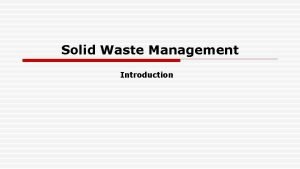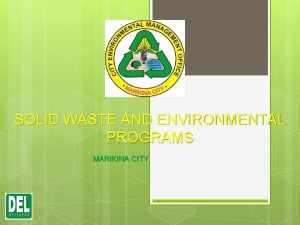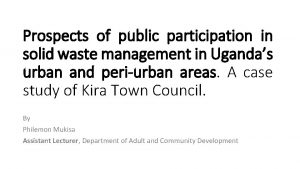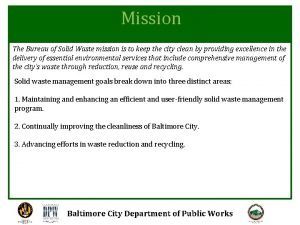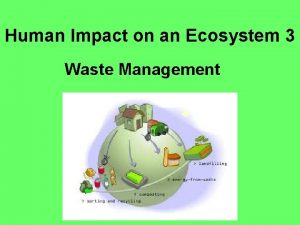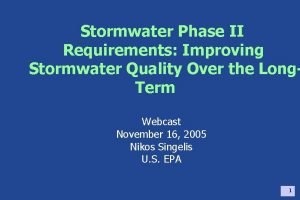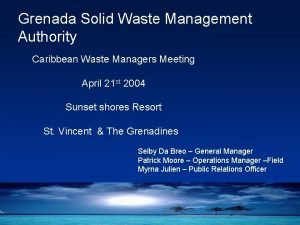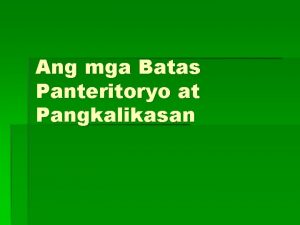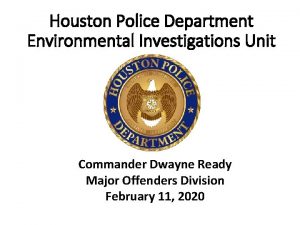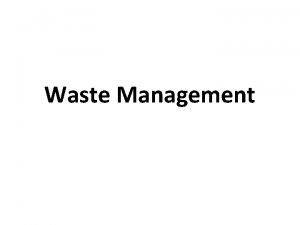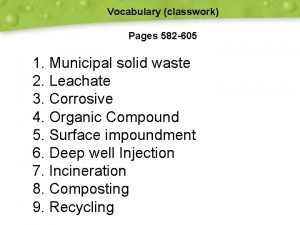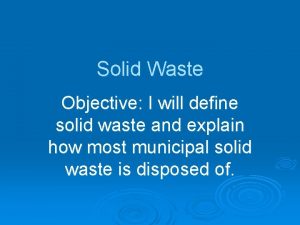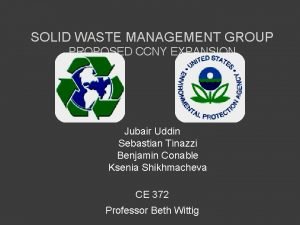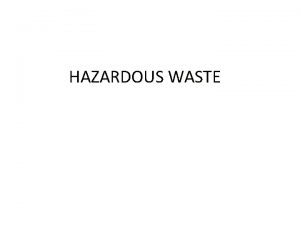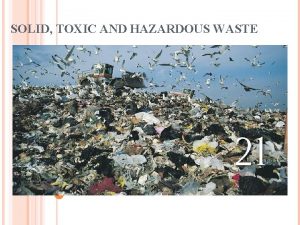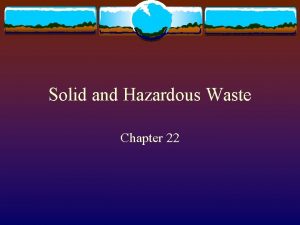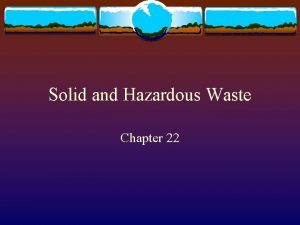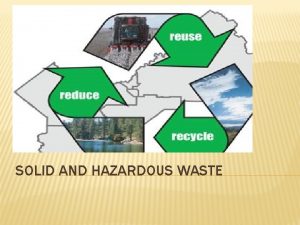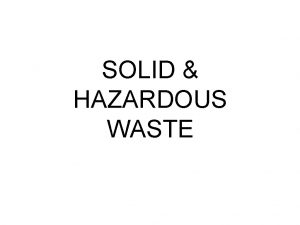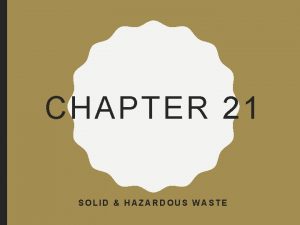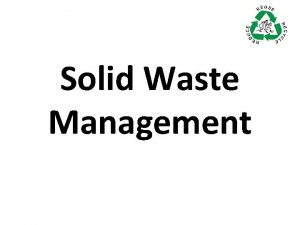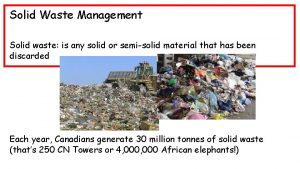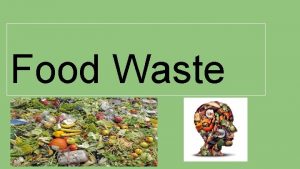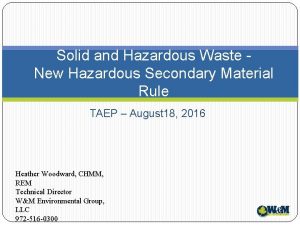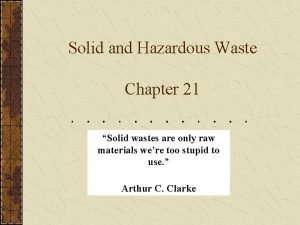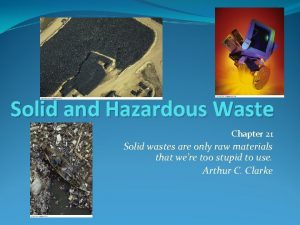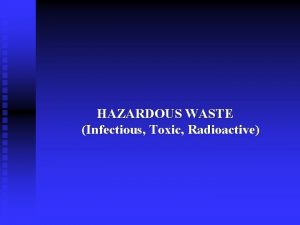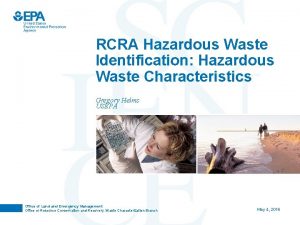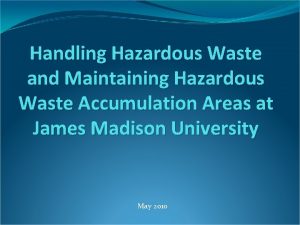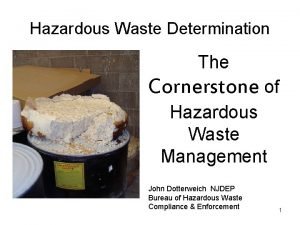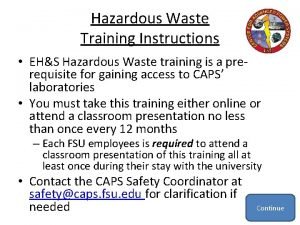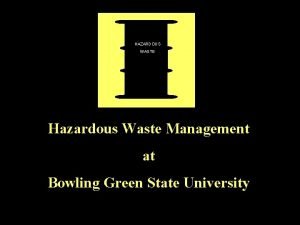CHAPTER 21 SOLID HAZARDOUS WASTE Food Waste is









































- Slides: 41

CHAPTER 21 SOLID & HAZARDOUS WASTE

Food Waste is the World's Dumbest Problem

TYPES OF SOLID WASTE ● Organic - Kitchen wastes, vegetables, flowers, or fruits. Something that will decay. ● Radioactive - Spent fuel rods and smoke detectors. Can take hundreds of thousands of years to decompose. ● Recyclable - Paper, glass, metals, and some plastics. ● Soiled - Hospital wastes, cotton, and cloth which can take 2 -5 months to decompose. ● Toxic - Paints, chemicals, pesticides, and so on. Can take hundreds of years to decompose.

PLANNED OBSOLESCENCE? • Until a society becomes wealthy they generate little waste – Every object that no longer has value for its original purpose is re-purposed – Prior to 1900: Almost everything recycled • After WWII: – Able to purchase things that could be used and thrown away – Shift toward designing a product in such a way that it would need to be replaced in a much shorter time – U. S. Is the leader of “Throw Away Societies”

MUNICIPAL SOLID WASTE (MSW) • Refuse collected by municipalities from households, small businesses, and institutions such as schools, prisons, municipal buildings and hospitals.

WASTE STREAM • Depending on what and how the materials, products, or goods are used, they can remain in the consumer use system for a long time • Ultimately all products wear out, lose their value, or are discarded • They enter the waste stream- the flow of solid waste that is recycled, incinerated, placed in a solid waste landfill, or disposed of in another way

COMPOSITION OF MUNICIPAL SOLID WASTE

TYPES OF DISPOSAL • R 3: Reduce, Reuse, Recycle • Composting • Land Disposal - Sanitary Landfill • Land Disposal - Open Dumping • Burning, Incineration, or Energy Recovery • Exporting • Remanufacturing

Reduce, Reuse, Recycle In the 1990 s people in the US began promoting the idea of diverting materials from the waste stream with a popular phrase #1 Reduce- less waste (or none) #2 Reuse- reusingle-use items #3 Recycle- materials are collected and converted into raw materials and then used to produce new objects (Divided into TWO categories…)

Closed- loop recycling: a discarded carpet can be recycled into a new carpet, new raw materials and additional energy are needed. Open – Loop Recycling: a beverage container is used once and then recycled into something else like a fleece jacket.

RECYCLING Pros: Cons: ● Turns waste into an inexpensive resource. ● Poor regulation. ● Reduces impact on landfills. ● Throwaway packaging is more convenient. ● Reduces energy requirements to produce product. ● Reduces dependence on foreign oil. ● Reduces air and water pollution. ● Beverage container deposit laws provide economic incentive to recycle. ● Fluctuations in market prices. ● Current policies and regulations favor extraction of raw materials. Energy, water, and raw materials are sold below real costs to stimulate jobs and the economy.

• Total weight of MSW recycled and % MSW recycled in US over time. • Today we recycle roughly 1/3 MSW, but places like Japan have recycling rates closer to 50%

REUSE Pros: ● Most efficient method of reclaiming materials. ● Industry models already in place auto salvage yards, building materials, etc. ● Refillable bottles can be used. Cons: ● Costs of collecting dropped-off materials on a large scale is expensive. ● Costs of washing and decontaminating containers is expensive. ● Only when items are expensive and labor is cheap is reuse economical.

E-Waste • Electronic waste from televisions, computers, cell phones comprise ~2% of the waste stream • E-waste can contain heavy metals like Lead, Mercury and Cadmium. • Much e-waste is exported to China where workers separate valuable metals from other materials using fire and acids often w/out personal protective equipment (PPE)

Composting • Organics that have decomposed under controlled conditions to produce a nutrient-rich material.

COMPOSTING Pros: ● Creates nutrientrich soil additive. ● Aids in water retention. ● Slows down soil erosion. ● No major toxic issues. Cons: ● Neighbors and HOA reactions to odor, vermin, and insects. ● NIMBY (Not In My Backyard) thinking

Municipal Composting Facility: typical facility collects almost 100, 000 metric tons of food scraps and paper year and turns it into usable compost

LANDFILLS • Municipality or private enterprise constructs a landfill at a substantial cost • Costs are recovered by charging a “tipping fee” because each truckload is put on a scale after the MSW is weighed it is tipped into the landfill • Tipping fees at solid waste landfills average around $35 per ton in the US • Create an economic incentive to reduce the amount of waste that goes to the landfill

Sanitary Landfills • Most solid waste is buried in landfills or incinerated • Sanitary landfills- engineered ground facilities designed to hold MSW with as little contamination of the surrounding environment as possible. • Leachate- the water that leaches through the solid waste and removes various chemical compounds with which it comes into contact. The fate of MSW in US.

A Modern Sanitary Landfill: Features include: Clay liner, leachate collection system, the cap, methane extraction system.

SANITARY LANDFILL Pros: Cons: ● Waste is covered each day with dirt to prevent insects and rodents. ● Rising land prices. Current costs are $1 million per 2. 5 acres. ● Plastic liners, drainage systems, and other methods help control leaching material into groundwater. ● Transportation costs to the landfill. ● Collection of methane and use of fuel cells to supplement energy demand. ● Legal liability. ● Use of anaerobic methane generators reduces dependence on other energy sources. ● Degradable plastics do not decompose completely. ● High cost of running and monitoring. ● Suitable areas are limited

PROBLEMS WITH LANDFILLS • No matter how careful the design and engineering, there is always the possibility that leachate from a landfill will contaminate underlying and adjacent waterways • EPA estimates that virtually all landfills in the US have had some leaching • Methane gas (a very persistent greenhouse gas) can also be released during decomposition of the garbage

OPEN DUMPING Pros: ● Inexpensive ● Provides a source of income to the poor by providing recyclables to sell. Cons: ● Trash can blow away in the wind. ● Vermin and disease. ● Leaching of toxic materials into the soil. ● It’s not very aesthetic.

Incineration • The process of burning waste materials to reduce its volume and mass and sometimes to generate electricity and heat.

BURNING, INCINERATION, OR ENERGY RECOVERY Pros: ● Heat can be used to supplement energy requirements. ● Reduces impact on landfills. ● Mass burning is inexpensive. ● What is left is 10 -20% of original volume. ● United States incinerates 15% of its wastes. ● France, Japan, Sweden, and Switzerland incinerate >40% of their wastes and use the heat to generate electricity. Cons: ● Air pollution including lead, mercury, NOx, cadmium, SO 2 , HCl, and dioxins. ● Sorting out batteries, plastics is expensive. ● No way of knowing toxic materials. ● Ash is more concentrated with toxic materials. ● Initial costs of incinerators are high. ● Adds to acid deposition.

PROBLEMS WITH INCINERATION • Generally tipping fees are much higher at incinerators than landfills, average around $70 per ton • May release air pollutants such as organic compounds from the incomplete combustion of plastics and metals • Require large quantities of MSW on a daily basis in order to burn efficiently and to be profitable

EXPORTING (OR SHIPPING OUR S**T SOMEWHERE ELSE!) Pros: Cons: ● Gets rid of problem immediately. ● Garbage imperialism or environmental racism. ● Source of income for poor countries. ● Long-term effects are not known. ● Expensive to transport.

REMANUFACTURING (MAKING OLD S**T NEW AGAIN!) Pros: ● Recovers materials that would have been discarded. ● Beneficial to inner cities as an industry because material is available and jobs are needed. Cons: ● Toxic materials may be present (CFCs, heavy metals, toxic chemicals, etc. ) ● Stigma of “remanufactured” instead of “new”

Hazardous Waste • Liquid, solid, gaseous, or sludge waste material that is harmful to humans or ecosystems. • Can be generated by small businesses such as dry cleaners, automobile service stations, small farms, and individual households – Oven cleaners, batteries, and lawn fertilizers

HAZARDOUS WASTE • Most municipalities do not have regular collection sites • Ask homeowners to store them in a safe location until periodic collections are held • Every aspect is more expensive and more difficult than the disposition of ordinary MSW • Collection sites for hazardous waste must be staffed with specially trained personnel. • Hazardous waste must be treated before disposal.

HAZARDOUS WASTE • Hazardous waste must be treated before disposal • EPA defines this as making it less environmentally harmful • The waste must usually be altered through a series of chemical procedures

Laws • Regulation and oversight of the handling of hazardous waste falls under two pieces of federal legislation: 1) Resource Conservation and Recovery Act (RCRA)- designed to reduce or eliminate hazardous waste. Also know as “cradle-to-grave” tracking. RCRA ensures that hazardous waste is tracked and properly disposed of.

Laws • 2) Comprehensive Environmental Response, Compensation, and Liability Act (CERCLA)- also know as “Superfund”. – Puts a tax on the chemical and petroleum industries. This revenue is used to cleanup abandoned and non-operating hazardous waste sites where a responsible party cannot be found. – Requires the federal government to respond directly to the release of substance that may pose a threat to human health or the environment

CERCLA - SUPERFUND ACT (1980) ○ Provides authority for the federal government to respond to releases or possible releases of hazardous substances that could threaten public health and/or the environment. ○ Established rules for closed and abandoned hazardous waste sites. ○ Established liability for corporations responsible for hazardous waste sites. ○ Created a trust fund for clean up if responsible parties for contaminated sites could not be found.

CERCLA - SUPERFUND ACT (1980) ○ ○ ○ The EPA and state agencies use the Hazard Ranking System (HRS) to calculate a site score (ranging from 0 to 100) based on the actual or potential release of hazardous substances from a site. A score of 28. 5 places a site on the National Priorities List, eligible for long-term remedial action (i. e. , cleanup) under the Superfund program. As of 9 August 2016, there were 1, 328 sites listed; an additional 391 had been delisted, and 55 new sites have been proposed.

NATIONAL PRIORITIES LIST (SUPERFUND) SITES The EPA’s list of National Priority List (NPL) of contaminated sites that are eligible for clean up funds

LOVE CANAL, NEW YORK HAZARDOUS WASTE CHEMICAL POLLUTION IN US, 1970’S An elementary school & housing development were constructed on top of large quantities of hazardous chemical waste site. Chemicals such as: Benzene, trichloroethylene, were found in the basements of homes resulted in a large # of illnesses. The site was listed as a superfund site, and inhabitants of the area were evacuated. Taken off the list in 1994 because the physical clean up had been completed & site no longer deemed threat to human health.

INTERNATIONAL CONSEQUENCES • Because of difficulties of disposing hazardous waste, municipalities and industries sometimes try to send the waste to countries with less stringent regulations • Illustrated by many reports of garbage and ash barges that travel the oceans looking for a developing country willing to accept hazardous waste from the US in exchange for cash

LIFE-CYCLE ANALYSIS • Important systems tool that looks at the materials used and released throughout the lifetime of a product– from the procurement of raw materials through their manufacture, use, and disposal • Also called the cradle-to-grave analysis • In theory it should help a community determine whether incineration is more or less desirable than using a landfill • BUT there are problems in determining the overall environmental impact of specific materials

INTEGRATED WASTE MANAGEMENT ● A method that seeks to develop as many options as possible, to reduce environmental harm and cost. ● Reduction, recycling, composting, landfills, and incineration are some ways IWM is utilized.

A RECYCLABLE CARPET & COLLECTION SITE FACILITY FOR EWASTE & RECYCLING IN CHILE. **Looking at holistic waste management -EX) Certain carpet manufacturers design their carpets so that when worn out they can be easily recycled into new carpeting
 Solid and hazardous waste
Solid and hazardous waste Section 3 hazardous waste answers
Section 3 hazardous waste answers Biomedical waste management introduction
Biomedical waste management introduction Msw apes
Msw apes What is toxic waste
What is toxic waste Stanislaus county hazardous materials division
Stanislaus county hazardous materials division Waste management references
Waste management references Hazardous waste transportation
Hazardous waste transportation Hazmat training alaska
Hazmat training alaska Potentially hazardous food is usually moist
Potentially hazardous food is usually moist Unit 2 food food food
Unit 2 food food food Sequence of food chain
Sequence of food chain Crystalline vs amorphous
Crystalline vs amorphous Example of a solid solution?
Example of a solid solution? Covalent molecular and covalent network
Covalent molecular and covalent network Example of crystalline solid
Example of crystalline solid Crystal solid and amorphous solid
Crystal solid and amorphous solid Crystalline solid and amorphous solid
Crystalline solid and amorphous solid Crystalline substances
Crystalline substances When a solid completely penetrates another solid
When a solid completely penetrates another solid Interpenetration of solids
Interpenetration of solids Sifting separation method
Sifting separation method Principles of waste management
Principles of waste management Introduction to waste management
Introduction to waste management Solid
Solid Marikina environmental programs
Marikina environmental programs Solid waste disposal introduction
Solid waste disposal introduction Conclusion of biomedical waste management
Conclusion of biomedical waste management 3r solid waste management
3r solid waste management Types of transfer stations in solid waste management
Types of transfer stations in solid waste management Rockwood solid waste
Rockwood solid waste Solid
Solid Disposal of garbage grenada
Disposal of garbage grenada Chemical composition of solid waste
Chemical composition of solid waste Mga batas pangkalikasan
Mga batas pangkalikasan How to reduce solid waste
How to reduce solid waste Material balance principle
Material balance principle Solid waste management
Solid waste management Sources of waste
Sources of waste 582 605
582 605 Define solid waste
Define solid waste Solid waste management objectives
Solid waste management objectives

